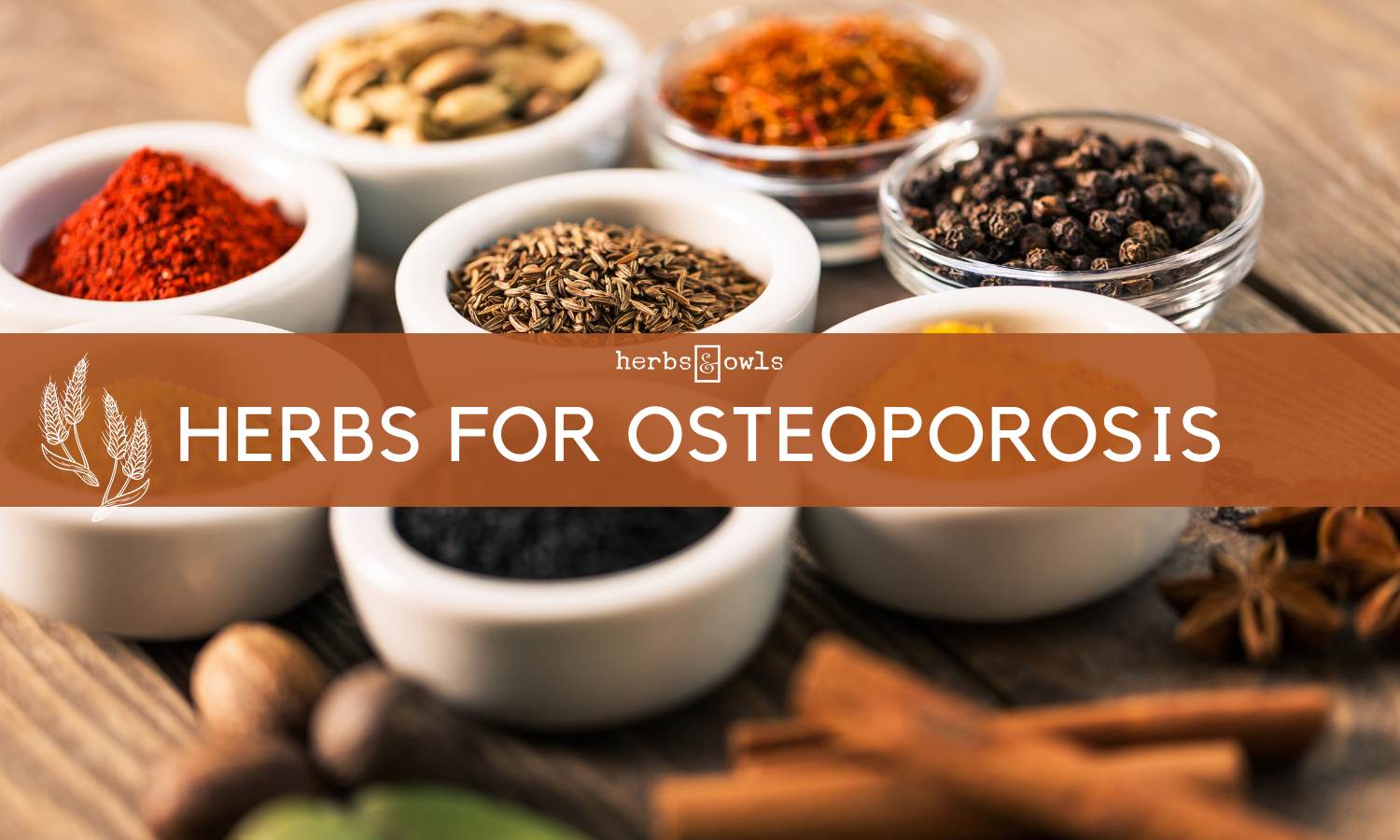Herbs For Osteoporosis
Our bones are constantly changing. New bone tissue is continually forming and old bone tissue is being removed, this cycle is called resorption and formation. Resorption and formation allow the skeletal system to maintain bone homeostasis.
Between the ages of 20 and 50, our bone density is at its most stable, where resorption and formation are happening in equal measures. After the age of 50, the process of resorption begins to happen at a faster pace, causing loss of bone density.
Although this is a normal process, some people will develop osteoporosis, a disease of the bone where excess bone mass is lost, causing the inside of the bone to become porous.
What Causes Osteoporosis?
There are many factors that can lead to osteoporosis, some of them include
Hormonal changes in women such as low estrogen levels
Loss of calcium, not enough vitamin D
Hormonal changes in men such as low testosterone levels
Genetics
Hormonal changes in both men and women can contribute to an increased chance of developing osteoporosis. Women are four times more likely to develop osteoporosis compared to men, especially after menopause when estrogen levels drop significantly. This drop in estrogen directly affects bone turnover due to the increase in osteoclast numbers.
The hormone testosterone contributes to bone density. When men stop producing enough testosterone, osteoporosis may begin to develop. Similar to women, when men are not producing normal levels of testosterone, the body cannot keep up with bone turnover and, as a result, the bones begin to weaken and become prone to breaks and fractures.
Low levels of vitamins and minerals like calcium and vitamin D can also cause osteoporosis. Calcium is used by the body to help produce healthy bones and teeth, send and receive nerve signals, and help with blood clotting. When the body is not getting or absorbing enough calcium, the parathyroid glands release a hormone called PTH (parathyroid hormone). This hormone signals the bones to release calcium into the bloodstream. If this continues for an extended period of time, the bones become brittle.
How Can Herbs Help?
Herbs are powerful allies that can help support our bodies.They provide us with nutrients like vitamins and minerals. With time, they can assist in restoring balance to systems that need it.
Oat straw (Avena sativa)
Oat straw is a nutritive tonic, this herbal ally is most widely known for her restorative and nourishing effect on the nervous system. Traditionally, its is known as one of the best anti-osteoporosis herbs because it’s rich in bone-building vitamins and minerals.
Oat straw contains:
Vitamins: A, C, E, K, and B complex
Minerals: iron, calcium, magnesium, silica, and zinc
As we state above, low calcium is one of the leading causes of osteoporosis, that’s where this wonderful herbal ally comes in, nourishing our bones and helping to replenish lost calcium.
Preparation: Oat straw is best prepared as an infusion. Infusions are similar to teas in that they are prepared using hot water and dried herbs. Infusions are generally left to steep for a longer period of time, 20 minutes up to 24 hours.
Horsetail (Equisetum arvense)
If you’ve ever seen a stalk of horsetail, you will quickly realize that it resembles the joints of the human body. Horsetail contains a high content of silica, which makes it a great herbal ally for maintaining bone health. It’s also high in vitamins and minerals other than silica.
Horsetail contains:
Vitamins B 1,2,3,5,6 ,C, E, K
Minerals silica, zinc, calcium, magnesium, iron, copper, potassium
A study published in 2012 sought to assess whether horsetail had any effects on bone regeneration. The study was done on human in vitro osteoclast precursors, these cell cultures were treated with Equisetum arvense extract. The results found that horsetail may have a beneficial effect on bone regeneration as it inhibits osteoclasts, which are responsible for breaking down the bone during the process of resorption.
Preparation: Horsetail is best taken as a tea. 2 teaspoons per 8. Oz cup of boiling water.
Alfalfa (Medicago sativa)
Alfalfa is an herbal ally high in calcium and vitamin D. It’s also one of the richest natural sources of vitamin K. Together, these vitamins and minerals contribute to the bone formation process.
Alfalfa contains:
Vitamins C, D, K
Minerals calcium, potassium, phosphorus, iron
Alfalfa sprouts contain phytoestrogen, these phytoestrogens act like the human hormone and may be a great ally for women during and after menopause when estrogen levels tend to drop.
Preparation: Alfalfa can be prepared as a tea, allowing the herbs to steep in a cup of boiling water for 5-10 minutes.
Nettle (Urtica dioica)
Nettle is one of our most popular spring tonics. It supports many of our body's systems like the immune, circulatory, respiratory, and nervous system. It has also been considered a bone-building herb due to its high calcium content. One cup of nettle may include as much as 300 mg of calcium.
Nettle contains:
Vitamins A, C
Minerals calcium, iron, selenium, zinc, magnesium
An animal study published in 2016 found that nettle may promote bone growth. Higher levels of bone formation were found in the group treated with stinging nettle extract.
Preparation: Nettle can be prepared in a variety of ways including teas, tinctures, and infusions. Nettle is also edible and can be added to soups and stews. The best way to extract calcium from nettle is through an overnight herbal infusion.

